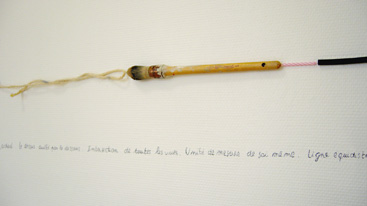
Born in Lübeck, Germany in 1937. Lives and works in New York, NY.

1976
Hand-written text on the wall, and objects.
50 x 1500 cm / Dimensions variables
Year of Purchase: 2008
Words and things.
Two parallel, horizontal lines on the wall. One is made up of various found objects, lined up as if following one another: threads, adhesive tape, pieces of rope, bits of pencil, etc. The other, running 15 cm below, is a hand-written line, spelling out a succession of lapidary formulas which could serve as alternative titles for the work or its auto-commentaries. Acting both as footnotes and the formalization of thinking in progress, these poetico-philosophical fragments evoke in turn the horizon, the border, exclusion, trajectory, as well as platitude and death. Two parallel lines, one virtual and literary, the other real and plastic. Two lines parallel in space and in their very essence, but which never meet: words and things. Irreducible distance between the visual and the discursive, between the work and the theory. This hybrid piece epitomizes the singularity of the Uruguayan, U.S.-based artist Luis Camnitzer, which lies in a fundamental tension between the poetic and the conceptual. Indeed, tautology and self-referentiality are characteristic of conceptual art: an utterance taking place of form and a protocol that precludes the aura of a unique object (the phrase must be recopied on the wall and objects may vary with each exhibition). At the same time, the work preserves its discreet materiality, and its visual aspect derives partly from the Apollinairian calligramme which, in an inverse gesture of conceptual dematerialization, transforms writing into an object, into a figurative form. On the other hand, the artist plays humorously and ambiguously with one of the structural motifs of minimal art: the straight line. It is a spiritual and formal guide of modernity, symbolizing stability, truth, and rigor, as opposed to hesitation, contortion, and lie. As Sol LeWitt put it: “The drawing of a person is not a person, but the drawing of a line is a real line.” Camnitzer playfully subverts this ontological axiom.
Camnitzer’s work, however, is not confined to artistic games, but is very open onto the world. Beyond the subtle questioning of representation, it contains, as always with Camnitzer, deeper, hidden signs of the relation between art and the political. Certain subterranean autobiographical motifs can be discerned in the work: the border, the transcultural, imprisonment. The straight line constitutes a division that cannot be overcome, an inescapable limit. It echoes in particular the artist’s forced long-term exile to the United States and his deep concern with South American dictatorships of the 1970s. Further, the collection of banal objects lined up on the wall brings to mind a prison esthetic, pragmatic and humble, made up of graffiti, pieces of string, garbage, and recycled material. The technique resonates with the artist’s other works devoted to political prisoners, tortured or condemned to death. At another level, this double, graphic and literary line could serve as a metaphor for the artist’s fundamental agonizing struggle, which gives his work its potency. Cultural, geographical, and artistic quartering. It is also a metaphor for the impossibility of joining the two sides of his relation to the world: on one hand political and real (objects), and conceptual and poetical (words), on the other. The line is a tightrope on which the artist, like an acrobat, advances by creating.
Guillaume Désanges